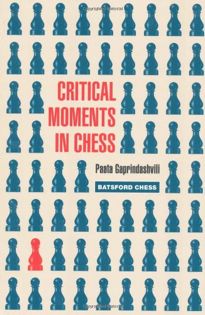Critical Moments In Chess
Paata Gaprindashvili

Batsford doesnt produce as many chess books as it did back in its heyday in the 1970s, but the past decade it has published some excellent titles. One can recommend any of the works of Andrew Soltis or Tibor Karolyi as well as Paata Gaprindashvilis Imagination In Chess. The latter book, which came out in 2004 by a hitherto unknown author, acquired cult status among hardcore chess studiers looking for training material besides the standard tactical puzzles. Now Gaprindashvili is back with his second book, Critical Moments In Chess.
The subject of Gaprindashvilis book, those critical forks in a game in which multiple choices are possible and failure to select the correct one has serious consequences, has been covered before, but not extensively. One might consider GM Josif Dorfmans The Critical Moment one of the pioneering works on the subject with fellow Ukrainian chess school graduate Adrian Mihalchisin’s ChessBase DVD Decision Making In Chess another.
Gaprindashvili addresses the subject of critical moments in six chapters.
* Critical Moments
* Critical Moments: struggle and capture of the initiative
* Critical Moments: development of the initiative, creation of an attack
* Critical Moments: obtaining and retaining the advantage; creation of counterplay; taking over the initiative from the opponent, etc.
* Critical Moments: delivering the decisive blow
* Exercises
Compared to Imagination In Chess there is great deal more prose in Critical Moments In Chess, both in the first five chapters where the subject is discussed at length, but also in the solutions offered to the 269 exercises. These solutions, in some cases covering the critical moment to the finish of the game, are often quite lengthy. The font size in Critical Moments In Chess is clearly larger than in Imagination In Chess, but even taking this into account there can be little doubt that the solutions offered in Critical Moments In Chess are more substantial.
These explanations should make the book more accessible to a wider audience but the flip side is that, sans diagrams, the solutions are hard to visualize for all but the strongest and most dedicated. Lacking diagrams in the solutions, students will need a board or may prefer to use this book in tandem with a product like ChessBase. There they could look up the game in MegaDatabase and then put the program into training mode where the game continuation is not visible.
This one caveat aside, Critical Moments In Chess is highly recommended for those prepared to put in some hard work.
